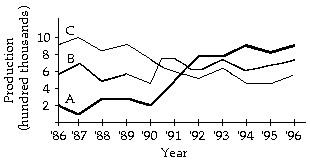Use synthetic division to find the quotient and the remainder.(2x3 + 3x2 + 4x - 10) ÷ (x + 1)
A. Q(x) = (2x2 + 5x + 9); R(x) = 1
B. Q(x) = (2x2 + 5x + 9); R(x) = -1
C. Q(x) = (2x2 + x + 3); R(x) = 13
D. Q(x) = (2x2 + x + 3); R(x) = -13
Answer: D
Mathematics
You might also like to view...
Express the given function as a composite of functions f and g such that y = f(g(x)).y = 
A. f(x) =  , g(x) = x2 - 9
, g(x) = x2 - 9
B. f(x) =  , g(x) = -
, g(x) = - 
C. f(x) =  , g(x) = x2 - 9
, g(x) = x2 - 9
D. f(x) =  , g(x) = x - 9
, g(x) = x - 9
Mathematics
Solve the problem.A company manufactures three products. The graph shows the production from 1986 to 1996. In what year did the production of C equal the production of A?
A. 600,000 B. 1996 C. 650,000 D. 1991
Mathematics
Divide.
A. 2 R 4 B. 3 C. 4 D. 2 R 5
Mathematics
Simplify using the rules for exponents. Use only positive exponents in your answer. ?
?  2
2
A. 
B. 
C. 
D. 
Mathematics